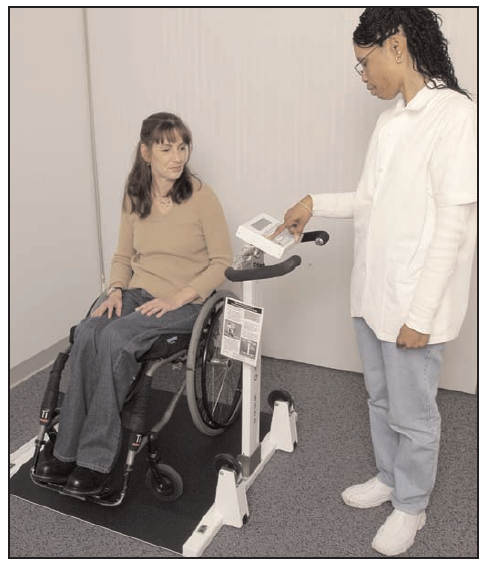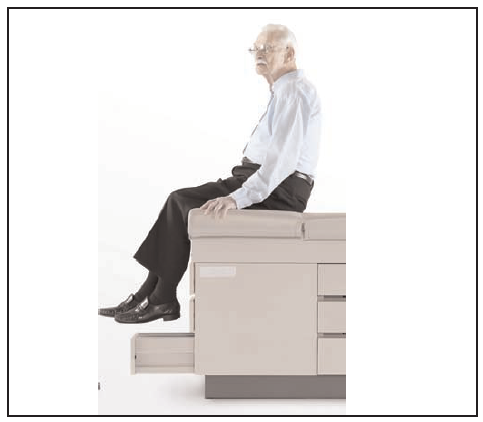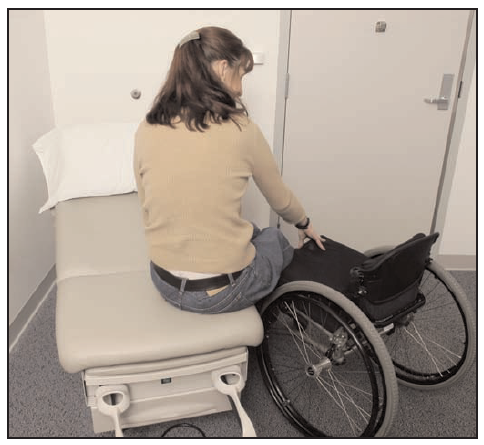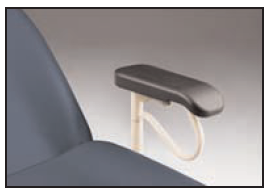3. Getting Access to Medical Equipment
No access to medical equipment can prevent people from getting appropriate medical services. In a national survey of people with disabilities or activity limitations, wheelchair users reported the following:
-
69% had difficulty using exam tables;
-
60% had difficulty being weighed due to inaccessible scales;
-
45% had difficulty using x-ray equipment, such as mammography equipment;
-
43% had difficulty using medical chairs.
In addition, 33% of all people with mobility disabilities experienced barriers accessing examination rooms.2
2 Kailes, J.I. (2006). The Patient’s Perspective on Access to Medical Equipment. In J. Winters and M. Story (Ed.), Medical Instrumentation: Accessibility and Usability Considerations (pp. 3-14). Boca Raton, FL: CRC Press.
3.1 Getting Weighed
Accessible scales are important to quality health care for people with disabilities. An accessible scale allows a wheelchair user to roll onto the platform of the scale. Someone who has poor balance, or who cannot step up, can walk on or sit on a chair on the scale platform.
Wheelchair user being weighed on accessible scale
The scale should have sturdy handrails, a high weight capacity (500+ lbs), and a slip-resistant platform. For more information on accessible scales and a list of manufacturers, look on the Internet at http://www.cdihp.org/briefs/brief2-weight-scales.html. You can use this document as a source of information for your health care provider.
Here are some reasons you can use to help your health care provider understand why having an accessible scale is important.
-
If your health care providers do not know your current and accurate weight, they may prescribe the wrong amount of medication for you.
-
Changes in weight can be important signs of health conditions.
-
Weight gain can be a sign of heart disease, high blood pressure, diabetes, reproductive problems and many other conditions.
-
Weight loss can be a sign of cancer, heart or digestive conditions, depression, and many other conditions.
-
-
If a health care office does not have an accessible scale, they must help people onto the scale, but this is not always possible for individuals with poor balance or who cannot stand.
-
When accessible scales are not available, patients may be unsafely assisted or lifted onto a standard scale. This type of assistance can also cause back or other musculoskeletal injuries to the medical facility staff.
-
An accessible scale benefits more than just patients who use wheelchairs. It can be used by anyone who has difficulty stepping up, balancing, standing on the small area of a standard scale or who may be too heavy to use a standard scale.
-
Accessible scales allow health care facilities to accurately obtain the weight of all patients and, therefore, comply with the ADA.
The national study of people with disabilities or activity limitations already mentioned found that 54% of 222 people with experience using weight scales had moderate or greater difficulty. Their issues included:
-
Standing scales may be unstable.
-
Scales have nothing to hold on to.
-
Scale displays are not usable by people with low or no vision.
Some survey respondents said they did not know their weight and had not been weighed in many years. Some reported that their health care providers often asked them to “guess” their weight, which was impossible.3
Maria had not been weighed in over 10 years, since the last time she had seen her doctor at the rehabilitation center. She had always just guessed her weight based on how her clothes fit her. But now she was pregnant and she knew that accurate measurement of her weight was an important part of her prenatal care. At first her doctor suggested that she go to the local rehab center, which was 10 miles away and arrange to be weighed there before each appointment.
This was not acceptable. It was a huge hassle (driving there, transferring in and out of the car, waiting, weighing, driving back, etc.) Maria mentioned that it would be helpful if the doctor got an accessible scale. Maria shared information on accessible scales at her next visit. She gave the same information to the office manager. Maria’s doctor agreed to purchase an accessible scale.
Maria was able to use the scale through her pregnancy. Awhile after the scale was purchased, her doctor commented that she had another patient who used a wheelchair that needed to use the scale and she also used the scale for an obese patient who couldn’t use the standard scale. It was quickly proving to be a worthwhile purchase for her office and helpful for many people, not just Maria. Actually the scale was used by all the doctor’s patients.
3 Kailes, J.I. (2006). The Patient’s Perspective on Access to Medical Equipment. In J. Winters and M. Story (Ed.), Medical Instrumentation: Accessibility and Usability Considerations (pp. 3-14). Boca Raton, FL: CRC Press.
3.2 Getting on the Table
The national survey also found that 75% of 291 people with experience using examination tables had moderate or greater difficulty using them. The height of exam tables was the most commonly reported complaint.4 A survey of approximately 400 Californians with disabilities found exam tables were inaccessible to 69% of wheelchair users, and 46% of cane, crutch and walker users.5
When getting health care, you usually have to get on and off of different types of equipment like tables and chairs. Many of these chairs and tables are high, which may be helpful to the doctor, nurse or technician, but difficult to impossible for you. If you cannot get onto the equipment, you may not get a thorough examination. Accessible tables and chairs that lower to 17-20 inches from the floor to the top of the cushion can make getting on and off them easier.
Traditional high exam table
Wheelchair user transferring onto accessible exam table
An accessible table is height adjustable to a minimum height of 17- 20 inches from the floor. Additional helpful features include an extra-wide top surface and higher weight capacity for larger people, adjustable side rails, positioning straps, and foot and leg supports that can be adjusted and locked.
Removable and adjustable side rail
For more information on accessible tables and a list of manufacturers, visit the Internet at http://www.cdihp.org/briefs/brief1-exam-tables.html. You can use this Internet document as a source of information for your doctor.
Holly uses a wheelchair. For quite a while she had been looking for a physician with a exam table that lowers to 17- 20 inches from the floor. Many of her co-workers went to physicians at a large and well-respected women’s clinic, so Holly called to ask if they had an accessible exam table. They said they did, so she made an appointment, excited that she had finally found a physician. When she arrived, she discovered that the table was not really accessible, it only lowered slightly and she couldn’t transfer onto it by herself. Holly reluctantly agreed to have two nurses lift her on the table for her exam, but they lifted her incorrectly. She fell and one of the nurses injured her back. Holly was okay, but she was embarrassed and upset and left without getting the exam.
Holly later felt she needed to do something about the problem, so she found the name of an accessible exam table manufacturer on the Internet and ordered a brochure. Holly sent the brochure and a letter to the clinic requesting that they purchase an accessible table. She was pleased when later they did purchase one.
There are important reasons for health care providers to have accessible examination and treatment tables and you can list these when talking to your doctor.
-
An accessible table allows for a more thorough exam, as compared to an exam where you remain seated in your wheelchair or on a chair.
-
A thorough exam can improve your chances of having any problems recognized and diagnosed, and allow any needed treatment to begin as early as possible. For example, some wheelchair users are at risk for developing pressure sores that may be missed if the individual cannot be examined on the exam table.
-
-
An accessible table reduces potential injuries to staff who may lift or help people transfer onto and off the equipment.
-
An accessible table is easier for everyone to use including patients who are obese, who have arthritis, older adults, pregnant women and anyone with a temporary or chronic condition that makes getting on a standard-height table difficult.
4 Kailes, J.I. (2006). The Patient’s Perspective on Access to Medical Equipment. In J. Winters and M. Story (Ed.), Medical Instrumentation: Accessibility and Usability Considerations (pp. 3-14). Boca Raton, FL: CRC Press.
5 Markwalder, A., Disability Rights Advocates (2005). A CALL TO ACTION: A Guide for Managed Care Plans Serving Californians with Disabilities. Oakland, CA: DRA





User Comments/Questions
Add Comment/Question